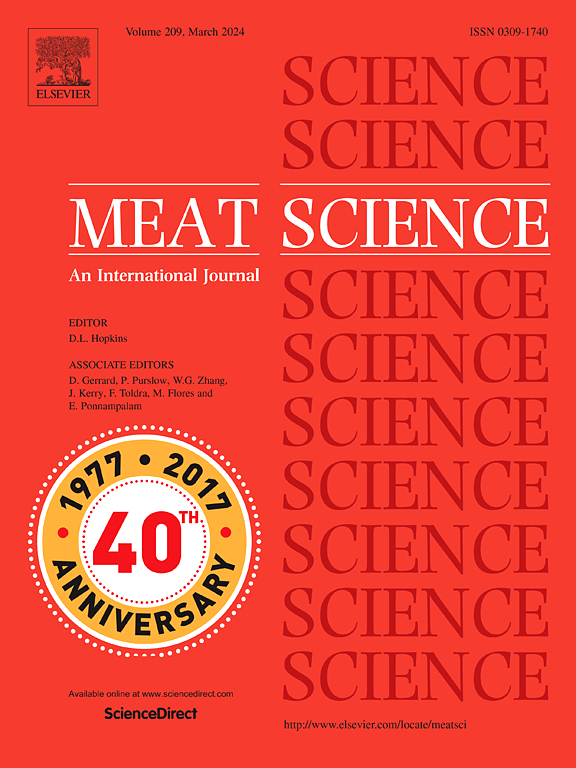缺氧诱导因子-1α通过诱导噬铁蛋白和促进牦牛胸腰长肌死后乳酸的产生来促进铁蛋白沉积。
IF 7.1
1区 农林科学
Q1 Agricultural and Biological Sciences
引用次数: 0
摘要
在死后缺氧环境中,铁蛋白沉积是肉质的一个新的关键调节因子,它在介导蛋白质氧化和细胞死亡方面发挥作用。然而,人们对铁变态反应与缺氧反应之间的相互作用,尤其是缺氧诱导因子-1α(HIF-1α)的参与仍研究甚少。本研究旨在确定 HIF-1α 是否会影响铁凋亡,如果会,则探讨其潜在机制。结果表明,HIF-1α介导的铁变态反应对肉色和持水能力(WHC)有负面影响,但能改善嫩度。与对照组相比,3-(5'-羟甲基-2'-糠基)-1-苄基吲唑(YC-1)抑制 HIF-1α 可减少铁变态反应,表现为脂质 ROS 水平、丙二醛(MDA)水平降低,谷胱甘肽(GSH)水平升高(P<0.05)。本文章由计算机程序翻译,如有差异,请以英文原文为准。
Hypoxia-inducible factor-1α promotes ferroptosis by inducing ferritinophagy and promoting lactate production in yak longissimus thoracis et lumborum postmortem
Ferroptosis has emerged as a novel, crucial regulator of meat quality in the postmortem hypoxia environment, with its role in mediating protein oxidation and cell death. However, the interaction between ferroptosis and the hypoxia response, especially the involvement of hypoxia-inducible factor-1α (HIF-1α), remains poorly studied. This study aimed to characterize whether HIF-1α influences ferroptosis, and, if so, explore the underlying mechanisms involved. The results showed that ferroptosis mediated by HIF-1α negatively impacts meat color and water holding capacity (WHC) but improving tenderness. Inhibition of HIF-1α by 3-(5′-hydroxymethyl-2′-furyl)-1-benzyl indazole (YC-1) reduced ferroptosis, as evidenced by lower lipid ROS levels, malondialdehyde (MDA), along with higher glutathione (GSH) levels compared to the control (P < 0.05). Additionally, inhibition of HIF-1α shifted iron homeostasis towards decreased uptake via downregulation of transferrin receptor 1 (TfR1) and induced export/storage via upregulation of ferroportin (FPN) and ferritin heavy chain (FTH) (P < 0.05). The relative expression of the ferritinophagy mediator nuclear receptor coactivator 4 (NCOA4), LC3-II/LC3-I ratio, and ATG were inhibited by YC-1 (P < 0.05), these findings suggest a general decrease in ferritinophagy associated with HIF-1α inhibition. YC-1-treated samples exhibited significantly diminished lactate accumulation and lactate dehydrogenase (LDH) activity compared to the control (P < 0.05). Unexpectedly, the inhibition of ferroptosis caused by YC-1 was further amplified by lactate enhancement, suggesting that lactate can exert its suppressive effects on ferroptosis independently of HIF-1α. Collectively, these findings demonstrate that HIF-1α drives ferroptosis by regulating iron metabolism, while lactate inhibits ferroptosis in a HIF-1α-independent manner. Overall, the HIF-1α mediated ferroptosis of postmortem yak muscle had a negative impact on WHC and color, while as a contributing factor of tenderness.
求助全文
通过发布文献求助,成功后即可免费获取论文全文。
去求助
来源期刊

Meat Science
工程技术-食品科技
CiteScore
12.60
自引率
9.90%
发文量
282
审稿时长
60 days
期刊介绍:
The aim of Meat Science is to serve as a suitable platform for the dissemination of interdisciplinary and international knowledge on all factors influencing the properties of meat. While the journal primarily focuses on the flesh of mammals, contributions related to poultry will be considered if they enhance the overall understanding of the relationship between muscle nature and meat quality post mortem. Additionally, papers on large birds (e.g., emus, ostriches) as well as wild-captured mammals and crocodiles will be welcomed.
 求助内容:
求助内容: 应助结果提醒方式:
应助结果提醒方式:


